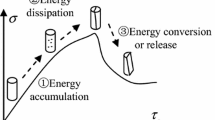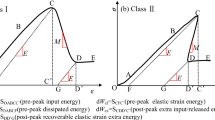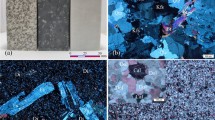Abstract
The brittleness of rocks plays an important role in the fracture network fracturing process of unconventional oil and gas reservoirs, the drilling efficiency of rock breaking and wall stability, and mining engineering. Rock brittleness has become one of the key parameters in the study of many rock mechanics and related engineering problems. However, there is still no widely accepted definition of brittleness. Although many criteria have been proposed to characterize rock brittleness, their applicability and reliability have yet to be verified. Therefore, brittleness evaluations require further study. In this paper, we divided the rocks under an external load into the unruptured area (body I system) and ruptured area (body II system). We considered that the body I system provided energy for the fracture of the II body. The brittleness of rock is understood as the ability of energy release when a post-peak fracture occurs in the II system. Therefore, the quasi-static energy-balanced equation of a double-body system was established and a new brittleness index was defined as the elastic energy release between an unsteady quasi-static state to the stable state of body II. The new index for brittleness evaluation proposed in this paper can not only quantify the brittleness of rock through the relation between the extremum of a softening modulus at the inflection point in the post-peak deformation curve of body II and the elastic modulus of body I but also ensure the position of the failure strain in the post-peak stage as well as reviewing the instant characteristics of the rock’s brittle crack. It is a new method to evaluate rock brittleness. Taking sandstone with different contents of brittle minerals as an example, the variation of the brittle index with the content of brittle minerals was studied.

















Similar content being viewed by others
References
Altindag R (2002) The evaluation of rock brittleness concept on rotary blast hole drills. J S Afr Inst Min Metall 102(1):61–66
Altindag R (2003a) Correlation of specific energy with rock brittleness concepts on rock cutting. J South Afr Inst Min Metall 103(4):163–171
Altindag R (2003b) The correlation of specific energy with rock brittleness concept on rock cutting. J S Afr I Min Metall 103(3):163–171
Altindag R (2010) Assessment of some brittleness indexes in rock-drilling efficiency. Rock Mech Rock Eng 43:361–370
Andreev GE (1995) Brittle failure of rock material: test results and constitutive models. A. A. Balkema, Rotterdam, pp 123–128
Aubertin M, Gill DE, Simon R (1994) On the use of the brittleness index modified (BIM) to estimate the post-peak behavior or rocks. In: Proceedings of the 1st North American rock mechanics symposium, Rotterdam, pp 945–952
Baron LI (1962) Determination of properties of rocks. Gozgotekhizdat, Moscow, pp 231–233
Bishop AW (1967) Progressive failure with special reference to the mechanism causing it. Proc Geotech Conf Oslo 2:142–150
Boruah A, Ganapathi S (2015) Microstructure and pore system analysis of Barren measures shale of Raniganj field. India J Nat Gas Sci Eng 26:427–437
Chen J, Zhang G, Chen H, Yin X (2014) The construction of shale rock physics effective model and prediction of rock brittleness. SEG technical program expanded abstracts, pp 2861–2865
Copur H, Bilgin N, Tuncdemir H, Balci C (2003) A set of indices based on indentation test for assessment of rock cutting performance and rock properties. J S Afr Inst Min Metall 103(9):589–600
Diao HY (2013) Rock mechanical properties and brittleness evaluation of shale reservoir. Acta Petrol Sin 29(9):3300–3306
Fic J, Pedersen PK (2013) Reservoir characterization of a “tight” oil reservoir, the middle Jurassic upper Shaunavon member in the Whitemud and Eastbrook pools. SW Saskatchewan Mar Pet Geol 44:41–59
Gholami R, Rasouli V, Sarmadivaleh M, Minaeian V, Fakhari N (2016) Brittleness of gas shale reservoirs: a case study from the north Perth basin. Austr J Nat Gas Sci Eng 33:1244–1259
Goktan RM, Yilmaz NG (2005) A new methodology for the analysis of the relationship between rock brittleness index and drag pick cutting. J South Afr Inst Min Metall 105:727–733
Grieser B, Bray J (2007) Identification of production potential in unconventional reservoirs. Production and Operations Symposium, Oklahoma, Society of Petroleum Engineers
Guo Z, Chapman M, Li X (2012) Exploring the effect of fractures and microstructure on brittleness index in the Barnett Shale. SEG annual meeting, Las Vegas, NV, pp 4609–4613
Honda H, Sanada Y (1956) Hardness of coal. Fuel 35(4):451–461
Hucka V, Das B (1974) Brittleness determination of rocks by different methods. Int J Rock Mech Min Sci Geomech Abstr 11(10):389–392
Huggett JM, Gale AS, Mccarty D (2010) Petrology and palaeoenvironmental significance of authigenic iron-rich clays, carbonates and apatite in the claiborne group, middle eocene, NE Texas. Sediment Geol 228(3–4):119–139
Jarvie DM, Hill RJ, Ruble TE, Pollastro RM (2007) Unconventional shale-gas systems: the Mississippian Barnett Shale of north-central Texas as one model for thermogenic shale-gas assessment. AAPG Bull 91(4):475–499
Jian** Z, Yaming H, Guojun X, **g L, Mengmeng L (2014) Study of energy-drop coefficient of brittle rock failure. Rock Soil Mech 35(2):321–327
** X, Shah SN, Roegiers JC, Bo Z (2014) Fracability evaluation in shale reservoirs-an integrated petrophysics and geomechanics approach. In: SPE annual technical conference and exhibition, society of petroleum engineers. SPE 168589
Kahramana S (2002) Correlation of TBM and drilling machine performances with rock brittleness. Eng Geol 65(4):269–283
Kahramana S, Altindag R (2004) A brittleness index to estimate fracture toughness. Int J Rock Mech Min Sci 41:343–348
Kidbinski A (1981) Bursting liability indices of coal. Int J Rock Mech Min Sci Geomech 18(4):295–304
Kivi IR, Zare-Reisabadi M, Saemi M, Zamani Z (2017) An intelligent approach to brittleness index estimation in gas shale reservoirs: a case study from a western Iranian basin. J Nat Gas Sci Eng 44:177–190
Lawn BR, Marshall DB (1979) Hardness toughness and brittleness: an indentation analysis. J Am Ceram Soc 62(7–8):347–350
Li Q, Chen M, ** Y et al (2012) Rock mechanical properties and brittleness evaluation of shale gas reservoir. Pet Drill Tech 40(4)
Li Y, Jia D, Rui Z, Peng J, Chunkai Fu, Zhang J (2017) Evaluation method of rock brittleness based on statistical constitutive relations for rock damage. J Petrol Sci Eng 153(05):123–132
Li Y, Long M, Zuo L, Li W, Zhao W (2019) Brittleness evaluation of coal based on statistical damage and energy evolution theory. J Pet Sci Eng 172:753–763
Li Y, Long M, Tang J, Chen M, **aofei Fu (2020) A hydraulic fracture height mathematical model considering the influence of plastic region at fracture tip. Pet Explor Dev 47:184–195
Liu Z, Sun Z (2015) New brittleness indexes and their application inshale/clay gas reservoir prediction. Pet Explor Dev 42(1):129–137
Luan X, Di B, Wei J, **angyang L, Keran Q, Jianyong X, Pinbo D (2014) Laboratory measurements of brittleness anisotropy in synthetic shale with different cementation. In: Proceedings of the 2014 SEG annual meeting. Denver, society of exploration geophysicists, pp 3005–3009
Meng F, Zhou H, Zhang C, Xu R, Lu J (2015) Evaluation methodology of brittleness of rock based on post-peak stress-strain curves. Rock Mech Rock Eng 48(5):1787–1805
Nygård R, Gutierrez M, Bratli RK, Høeg K (2006) Brittle–ductile transition, shear failure and leakage in shales and mud rocks. Mar Pet Geol 23(2):201–212
Özfırat MK, Yenice H, Şimşir F, Yaralı O (2016) A new approach to rock brittleness and its usability at prediction of drillability. J Afr Earth Sci 119:94–101
Protodyakonov M (1962) Mechanical properties and drill ability of rocks. In: Proceedings of the 5th symposium on rock mechanics, University of Minnesota, Minneapolis, University of Minnesota, USA, pp 103–118
Quinn JB, Quinn GD (1997) Indentation brittleness of ceramics: a fresh approach. J Mater Sci 32(16):4331–4346
Rickman R, Mullen MJ, Petre JE, Grieser WV, Kundert D (2008) A practical use of shale petrophysics for stimulation design optimization: All shale plays are not clones of the Barnett Shale. In: Proceedings of the SPE annual technical conference and exhibition, society of petroleum engineers. SPE 115258
Rickman R, Mullen MJ, Petre JE, Grieser B, Kundert D (2008) A practical use of shale Petro physics for stimulation design optimization: all shale plays are not clones of the Barnett Shale. In: SPE annual technical conference and exhibition, society of petroleum engineers
Rybacki E, Meier T, Dresen G (2016) What controls the mechanical properties of shale rocks? Part II: brittleness. J Petrol Sci Eng 144:39–58
Sena A, Castillo G, Chesser K, Voisey S, Estrada J, Carcuz J, Carmona E, Hodgkins P (2011) Seismic reservoir characterization in resource shale plays: stress analysis and sweet spot discrimination. Geophysics 30(7):758–764
Shi X, Liu G, Cheng Y, Yang L, Jiang H, Chen L, Wang J (2016a) Brittleness index prediction in shale gas reservoirs based on efficient network models. J Nat Gas Sci Eng 35:673–685
Shi X, Liu G, Cheng Y, Yang L, Jiang H, Chen L, Jiang S, Wang J (2016b) Brittleness index prediction in shale gas reservoirs based on efficient network models. J Nat Gas Sci Eng 35:673–685
Sun SZ, Wang KN, Yang P, Li XG, Sun JX (2013) Integrated prediction of shale oil reservoir using pre-stack algorithms for brittleness and fracture detection. In: International petroleum technology conference, Bei**g. 6, 4731–4738, paper ITPC 17048-MS
Tarasov BG (2011) Experimental evidences of dramatic embrittlement of hard rocks due to rising confining pressure at triaxial compression. In: Harmonising rock engineering and the environment–12th ISRM international congress on rock mechanics, pp 845–849
Tarasov B, Potvin Y (2013) Universal criteria for rock brittleness estimation under triaxial compression. Int J Rock Mech Min Sci 59:57–69
Wang FP, Gale JF (2009a) Screening criteria for shale-gas systems. Gulf Coast Assoc Geol Trans 59:779–793
Wang FP, Gale JF (2009b) Screening criteria for shale-gas systems. Gulf Coast Assoc Geol Soc Trans 59:779–793
Wang D, Ge H, Wang X, Wang J, Meng F, Suo Y, Han P (2015) A novel experimental approach for Fracability evaluation in tight-gas reservoirs. J Nat Gas Sci Eng 23:239–249
Wang T, Zhang T, Ranjith PG, Li Y, Song Z, Wang S, Zhao W (2020) A new approach to the evaluation of rock mass rupture and brittleness under triaxial stress condition. J Pet Sci Eng 184:106482
**a YJ, Li LC, Tang CA, Li XY, Ma S, Li M (2017) A new method to evaluate rock mass brittleness based on stress-strain curves of class I. Rock Mech Rock Eng 50:1123–1139
Yagiz S (2009) Assessment of brittleness using rock strength and density with punch penetration test. Tunn Undergr Space Technol 24:66–74
Yang L, Ge H, Shen Y, Zhang J, Yan W, Wu S, Tang X (2015) Imbibition inducing tensile fractures and its influence on in-situ stress analyses: a case study of shale gas drilling. J Nat Gas Sci Eng 26:927–939
Zhang D, Ranjith PG, Perera MSA (2016) The brittleness indices used in rock mechanics and their application in shale hydraulic fracturing: a review. J Pet Sci Eng 143:158–170
Zhang H, Wang Z, Ruan B, Li Z, Zhao W, Ranjith PG, Wang T (2017) A brittleness evaluation method of rock constitutive relationship with Weibull distribution based on double-body system theory. Energy Sci Eng
Zhou H, Chen J, Lu J, Jiang Y, Meng F (2018) A new rock brittleness evaluation index based on the internal friction angle and class I stress-strain curve. Rock Mech Rock Eng 51(7):2309–2316
Zuo J, Huang Y, **ong G et al (2014) Study of energy-drop coefficient of brittle rock failure. Rock Soil Mech 35(2):321–327
Acknowledgements
This research was supported by National Natural Science Foundation of China (Grant No. 51574088, Grant No. 51404073), Heilongjiang Provincial Natural Science Foundation of China (Young Scientists) (Grant No. QC2017043), China Postdoctoral Science Foundation (Grant No. 2018M630335), HeiLongJiang Postdoctoral Foundation (LBH-Z19008), Key Young Project of Northeast Petroleum University “National Foundation” Cultivating foundation (Science) (2017PYQZL-15), Talented Reserves of Heilongjiang Province Science Foundation for Distinguished Young Scholars of Northeast Petroleum University (SJQHB201802), Natural Science Foundation of Heilongjiang Province of China (YQ2019E007), Talented Reserves of Heilongjiang Province Science Foundation for Distinguished Young Scholars of Northeast Petroleum University (Study on the propagation of acoustic emission signal in real time expansion of pulsating hydraulic fracture network in shale reservoir).
Author information
Authors and Affiliations
Corresponding author
Ethics declarations
Conflict of interest
The authors declare no conflicts of interest. To the best of our knowledge, the named authors have no conflict of interest, financial or otherwise.
Additional information
Publisher's Note
Springer Nature remains neutral with regard to jurisdictional claims in published maps and institutional affiliations.
Rights and permissions
About this article
Cite this article
Wang, T., Zhang, H., Gamage, R.P. et al. The evaluation criteria for rock brittleness based on double-body analysis under uniaxial compression. Geomech. Geophys. Geo-energ. Geo-resour. 6, 49 (2020). https://doi.org/10.1007/s40948-020-00165-x
Received:
Accepted:
Published:
DOI: https://doi.org/10.1007/s40948-020-00165-x




